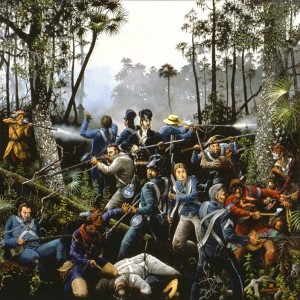
Saturday Jul 17, 2021
SW065 Sword-Swinging General Scolds Soldiers, Steeles Resolve at Withlacoochee River Battle

Jackson Walker painting of the Battle of Withlacoochee
In January and February of 1836, the eyes of the United States in the press were concentrated upon the Withlacoochee River, where a relative handful of Seminole and Mikosukee warriors and their families were ensconced to resist the Indian removal policy of the United States.
We’ve discussed how the path to the Second Seminole War was paved with tariffs, land grabs, broken treaties – and a fundamental misunderstanding on the part of the US Government about who the Seminole were. For its own convenience, rather than deal with more than a dozen different bands of Seminole tribes, the US Government created the political fiction of a unified Seminole nation. In fact, the Seminole comprised many disparate tribes from different backgrounds and cultures. Although loosely aligned throughout the Florida territory, their primary unity came from opposition to forced removal west to the Oklahoma Territory.

The commanding general in Florida, Duncan L. Clinch, had dealt with Seminole for more than a decade. Despite unrest and scattered Seminole violence against sugar plantations in East Florida in the last half of 1835, Clinch held out hope to secure an agreement. He amassed a military force to march from Fort Drane to meet the Seminole chiefs in the Withlacoochee River region of Central Florida. He intended to awe the Seminole with his Army’s strength so that the Seminole would, in his view, recognize resistance was futile and they should prepare to pack their bags to leave Florida on waiting transport ships in Tampa Bay. And if the Seminole rebuffed his last peace overture, his Army would crush them and deport the survivors. He failed to recognize the Seminole had a vote in this proposal and that they had other ideas about the removal policy; namely, they would refuse to leave, but would fight by force of arms to the last Indian rather than consent. The Battle of the Withlacoochee was the first U.S. Army-planned engagement with the Seminole. The inconclusive battle came around the same time Seminole were ambushing a 108-soldier column moving along the Fort King Road from Fort Brooke, Tampa. When troops faltered in the battle, Clinch unsheathed his sword and waved his symbol of authority to motivate troops to maintain discipline and form properly to fight. 
Map that shows location of Fort Drane, the later Fort Clinch, and the Dec. 31, 1835 location of the battle with the Seminoles in the Withlacoochee. (Above) (Below) a notional reproduction of a typical military fort of the era.

Autodidact, living historian, and military reenactor Jesse Marshall returns to the Seminole Wars podcast to answer these questions and to provide perspective on why things went the way they did. The outcome was not foreordained.

Seminole War soldier reenactor Jesse Marshall explains the situation to Matt Milnes, admist other Soldier-reenactors. (Above) (Below) Jesse Marshall appears at living history events as an 1830s Florida Cracker. 
Host Patrick Swan is a board member with the Seminole Wars Foundation. He is a combat veteran and of the U.S. Army, serving in Iraq, Afghanistan, Kuwait, and Kosovo, and at the Pentagon after 9/11. A military historian, he holds masters degrees in Public History, Communication, and Homeland Security, and is a graduate of the US Army War College with an advanced degree in strategic studies. This podcast is recorded at the homestead of the Seminole Wars Foundation in Bushnell, Florida.
Like us on Facebook, LinkedIn, and YouTube. Get the latest episode without delay where and when you want it by subscribing through your favorite podcast provider, such as iHeart, Stitcher, Spotify, DoubleTwist, Pandora, Podbean, Google podcasts, iTunes or directly from the Seminole Wars Foundation website at www.seminolewars.us
No comments yet. Be the first to say something!